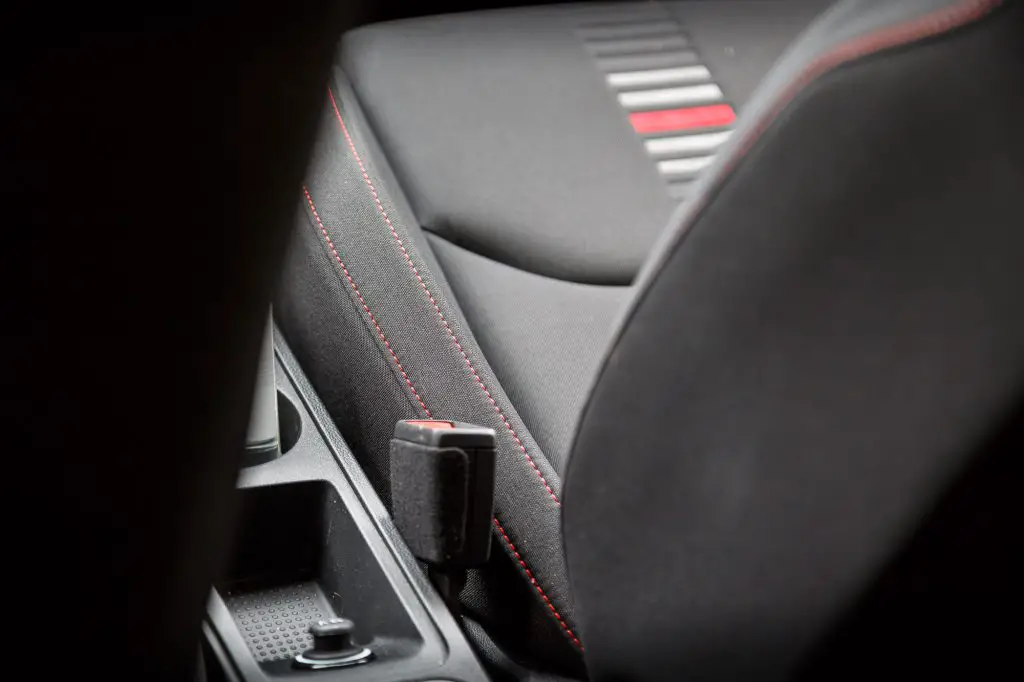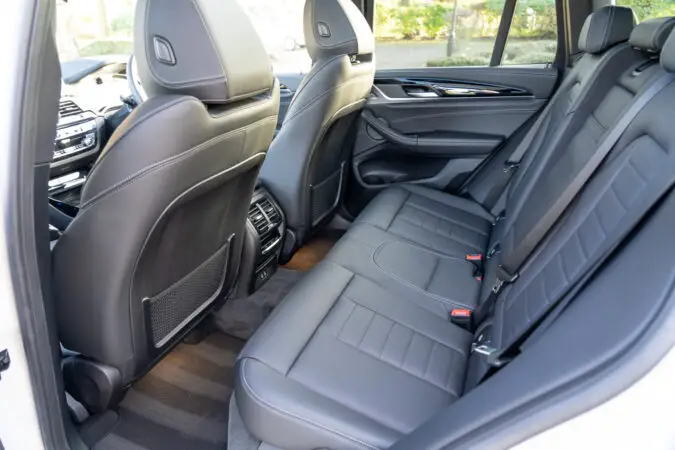The seat belt is one of the most essential car safety features. However, occasionally the device may not function as intended due to obstructions inside the seat belt buckle. To access the inside of the buckle more easily, you might even need to remove one of the seats. Fortunately, it can be fixed rather than having to replace the entire seat belt system.
Examining the seat belt buckle, opening it to check for damage inside, and putting it back together is all it takes to repair it. The only option left to you for your on-road safety if these methods don’t work is to replace the buckle.
So what is the proper way to fix a seat belt buckle? The buckle of a seat belt is the component that opens and fastens the seat belt. You can fix your seat belt buckle using just a few simple tools. We will cover the procedure you need to follow as well as the basics of the seat belt.
- History Of Seat Belt
- Three-Point Seat Belt
- Working And Components Of Seat Belt
- Seat Belts Material
- Seat Belt Buckle Replacement
- Stuck Seat Belt Buckle
- Final Conclusion
- FAQs
Seat Belt
Seat belts assist in occupant positioning, which lowers the risk of injury in many types of collisions. The seat belt is also built to stretch at a controlled rate to absorb impact energy and lessen the severity of the occupant’s deceleration. According to studies, seat belts cut the risk of fatalities by about 45% and the chance of serious injuries in crashes by about 60%.
Motor vehicle accidents are the leading cause of death among people aged 1 to 54 in the country. The National Highway Traffic Safety Administration (NHTSA) estimates that seat belts save more than 12,500 lives each year and prevent over 300,000 serious injuries in the country alone.
Initially, seat belts were created not for use in automobiles. They were intended for painters, firefighters, and other workers who needed to be restrained properly. It wasn’t until the early 1950s that a Californian doctor did a study on seat belts. He found a correlation between the rudimentary seat belts and a drop in the high number of head injuries.
After his study was published, automakers began using his retractable seat belt design in various vehicles (for some context, check out our guide on how to fix your seat belt that won’t retract). Nash and Ford were the first automobile manufacturers to include seat belts, rapidly followed by Saab.
History Of Seat Belt
The seat belt was developed by English engineer George Cayley in the late 1800s to help keep glider pilots inside their craft. However, in 1885 Edward J. Claghorn, an American invented the first patented seat belt in New York City. It was intended to protect tourists traveling in cabs.
The seat belt gradually began to appear in manufactured cars over time. It was equipped in cars in order to assist drivers and passengers in staying put in their seats. However, driving safety in general received less attention. So, when were seatbelts mandated into law, then?
Despite being invented in the late 1800s, seat belts weren’t made mandatory until the middle of the 1930s. During this period a number of American doctors tested them and noticed their benefits right away. This pushed automakers to include them in all vehicles. Initially, the Sports Car Club of America (SCC) mandated that competitors wear lap belts during events.
Followed by this, a motor vehicle seat belt committee was established by the Society of Automotive Engineers (SAE) the year after. Race car drivers were the first people who actually wore seat belts to assist prevent them from suffering life-threatening internal injuries. Nowadays, driving without one will lead you to a hefty seat belt tickets cost.
Three-Point Seat Belt
The three-point seat belt, created in 1958 by Swedish engineer Nils Bohlin, represents the real advancement in modern seat belt technology. The seat belts used in automobiles up to this point were two-point lap belts that buckled over the abdomen and were worn across the body.
After Volvo hired Bohlin in 1958, he designed the three-point seat belts that are still in use today. These protect both the driver and passengers in the event of an accident. The three-point design was developed for the purpose of securing the top and lower bodies. Other automakers copied this seat belt design because it was straightforward and efficient.
When Bohlin passed away in 2002, Volvo calculated that over a million lives had been saved by seat belts in the four decades since their introduction. Sales of seat belts soared once the general public in the United States became convinced of their safety benefits. Seat belts were offered as an optional extra by auto manufacturers and even sold at neighborhood gas stations.
American cars have been required to have seat belts since 1966. Seat belt regulations began to be implemented in the United States with the passing of the National Traffic and Motor Vehicle Safety Act of 1966. As a result, seat belt usage in cars was mandated in the majority of first-world nations by 1975.
Laws quickly followed once they started to appear more frequently in automobiles. Despite the fact that they had to be in cars by law, seat belt regulations were a different matter. All states in the US currently have laws requiring the use of seat belts.
Currently, automakers are attempting to improve the comfort and convenience of using seat belts. These include crisscross experimental safety belts to seat belts made to fit each of our specific bodies.
Working Of Seat Belt
The fundamental goal of a seat belt is to keep passengers safe in the case of a collision. The seat belt works by preventing the driver or passenger from abruptly stopping or losing velocity. It does this by keeping them in a more static motion.
The tendency of an object to move until something acts to stop it is known as inertia. It is what enables an automobile to drive. That inertia varies when the vehicle impacts or is struck by something. Without a seat belt, passengers risk being totally thrown out of the vehicle or into various parts of the interior. This is typically prevented by the seat belt.
When a seat belt is worn correctly, the stopping force is distributed across the wearer’s pelvis and rib cage. It directs the force in these two places of the torso, which are two of the stronger body sections. This helps to lessen the impact of the accident on the body.
A sturdy yet flexible webbed cloth serves as the material for the seat belt itself. When worn properly, it should allow for a little amount of movement. But to protect a person in a crash, it must be a tight fit with little give.
Components Of A Seat Belt
A Y-shaped belt called a three-point seat belt combines a sash belt with a lap belt. The 3-point belt disperses the energy of the moving body over the chest, pelvis, and shoulders in a collision. The following are the main components of a 3-point seat belt–
- A belt made of webbed cloth that keeps a driver or passenger inside the car in the event of an accident or rapid braking.
- The retractor box that holds the seat belt while it is not in use.
- The spool and spring mechanism, also housed by the retractor box facilitates both the smooth unspool and automatic re-spooling of the seat belt upon unlocking.
- The metal tab known as the tongue that locks into the buckle.
- The seat belt buckle secures the tongue and locks it in position.
The belt itself is constructed from a webbed cloth. The spool and spring used to roll the belt onto the vehicle’s interior wall or floor are located in the retractor box. The seat belt can be pulled out by the occupant by unwinding it from the spiraling spring. The same spiraling spring will re-spool itself when the seat belt is released.
Lastly, there is the lock itself. The webbed fabric of the seat belt ends in a metal tab known as the tongue (it might be handy to figure out how to clean car seats fabric yourself and how to clean fabric car seats). The belt is untied and positioned across the wearer’s body. Followed by this, inserting the tongue into the buckle locks the seat belt in position.
The occupant should be sitting upright in the seat with their backs against the back of the seat as the seat belt is being buckled. The seat belt is currently the best form of vehicle safety equipment when worn appropriately at all times.
Seat Belt Buckle
The seat belt buckle holds and releases the tongue of the seat belt, which is fastened to the webbing. The seat belt can be attached and loosened with a minimum of energy. This is because of the buckle’s ability to hold the tongue firmly in place.
Additionally, it is designed so that, in the event of an accident, a second person may quickly separate the tongue from the buckle and release the passenger.
Seat Belts Material
Seat belts are a marvel of engineering. That is not merely because of the mechanisms that spool out and tension the seat belt. Webbing, the cloth that makes up the belt, is specifically engineered to have tremendous tensile strength—roughly 3000-6000 lbs. Since they were implemented by the automotive industry in the 1950s, they have prevented a significant number of deaths annually.
The first seat belt webbing was produced using shuttle looms. These had a maximum weaving speed of only 200 picks per minute. Since 1975 webbing is mostly produces using needle looms, which can achieve up to 1000 picks per minute. However using modern looms, it is possible to weave up to 3000 picks per minute.
Nowadays, seat belt fabric is typically made of 100% polyester. Prior to polyester’s rise to popularity, nylon was the material of choice. However, nylon stretches more than polyester and is more prone to damage. That difference is crucial since even minor belt wear and abrasions drastically lower the tensile strength.
Additionally, seat belts have robust threads that are reinforced with specifically crafted run-proof selvages while still preserving the flexibility of the belts. Also, because the threads can pack closer together, research has shown that less-energized yarns produce seat belts that are more robust. In most cases, seat belt webbing has 300 warp threads per 46mm belt or almost 150 ends per inch.
Typically, seat belts are made of an 8-shaft herringbone twill or a satin weave. Take a closer look at your seat belt the next time you’re in your car and try to interpret the fabric for yourself.
Seat Belt Buckle Replacement
Driving while your seat belt buckle is malfunctioning is incredibly dangerous. Seat belts have been saving lives for many years. Since they are seriously essential, every passenger in a car must wear them. You’ll be able to fix your damaged seat belt buckle using the specific steps listed below. You will need a butter knife along with a set of screwdrivers.
Step #1: Examine The Seatbelt
First, carefully inspect the belt before attempting to repair the seat belt buckle. If there is a blockage on the belt, it is possible to remove it and restore the belt’s functionality. Over time, dirt, filth, and other particles can easily assemble due to the seat belt’s position. If you can see anything stuck there, you might be able to pry it off.
Given the way the buckle is constructed, there is a good chance that something could end up becoming stuck inside. See if there are any obstructions, and if so, you must get rid of them. Insert the knife’s sharp tip into the buckle by advancing it through the edges.
By doing this, you can clean the buckle’s interior, which might make your seat belt functional again. However, if it is still broken, you can go to the following step.
Step #2: Remove The Buckle
If the aforementioned measures weren’t able to fix your seat belt’s problem, it’s probably inside the buckle. To get a better view, you must take the buckle’s female end out of the seat. You must remove the buckle in this circumstance. It might be fastened together using screws or you might have to remove the seat itself.
Step #3: Disassemble The Buckle
The socket between the edges can be seen once the buckle has been taken from the seat. You must take out every screw in order to disassemble it. Simply pry it apart if there are no screws to be removed.
You should exercise caution, though, as you don’t want to harm some of the interior parts. The process of taking apart the seat belt buckle won’t take long. However, keep in mind that the buckle has tiny springs that could leap out when you open it.
Step #4: Inspect The Internal Operation
When you open the buckle, a little system that allows you to instruct the tongue to be caught and released will be visible. Obviously, if the buckle is harmed, the seat belt won’t operate properly. This implies that you must check its operation after it is opened.
You should be able to examine every internal component once the buckle has been opened. The inside of the buckle is made up of three primary parts: a red push button, a cam, and springs. If you push it in and firmly hold it together, the cam should catch the tongue. With the assistance of the springs, the tongue and cam both become looser after you hit the red button.
To find out what happens next, depress the button. Anything that was obstructing the movement should now be simple to remove. The buckle may, however, not be functioning due to worn-out components. In that case, advise skipping the next step and going on to the final step rather than rebuilding the buckle.
Step #5: Reassemble The Buckle
When finished, gently put the buckle back together and set it in its original position. Cleaning the areas between the seats is also necessary (for more insight, check out our guides on how to clean leather car seats, how to clean car seats, and how to clean cloth car seats). The likelihood of debris making its way down there and gradually settling within the seat belt buckle is high.
Issues with seat belt buckles frequently occur because of this reason. If you were unable to fix the problem, however, your only option is to replace it with a new one.
Step #6: Replacing The Buckle
Some individuals love fiddling with broken objects, like seat belt buckles. But repairing a worn-out seat belt buckle can take time. Although there are kits for rebuilding the seat belt, it makes more sense to simply replace it.
Since the rest of the seat belt is likely to be worn as well, you can also think about replacing it entirely. For the parts, seat belt replacement kits typically range in price from $25 to $100. If you can install it yourself, there’s no need to pay for additional labor. Hiring someone to replace it might raise your cost by another $100 to $200.
Common Problems With The Seat Belt
The most commend issue is when seat belts get tangled when aren’t properly taken out or allowed to spool back. This seat belt issue can usually be resolved with a quick fix: totally unwind the seat belt, untangle it as you go, and then slowly feed it back.
However, a qualified mechanic should be contacted if the seat belt is out of alignment, or if it seems that there is a problem with the spool or retractor box. A seat belt could occasionally get frayed or unspool completely. A qualified mechanic should do this repair and might call for replacing the seat belt itself.
Finally, the joint between the tongue and the buckle may deteriorate. If that occurs, the seat belt is no longer operating as efficiently as it should. Again, a qualified mechanic needs to be consulted to repair the tongue and buckle.
Stuck Seat Belt Buckle
The aforementioned instructions were given with the notion that the seat belt had been released from the buckle. However, there are situations where you could be caught in the seat belt (such as how your seat belt won’t pull out and it’s jammed), making it much more difficult to fix.
In this situation, you should spray a lubricant such as WD-40 into the seat belt buckle opening. Shake it a little to help the lubricant settle on top of the mechanical parts inside. After a while, try pressing the button to release the buckle once more. If it doesn’t work, you may always apply more pressure and lubricant.
After you manage to unlock it (and have figured out how to fix a stuck seatbelt), you should liberally lubricate the mechanism’s interior. Check the seat belt’s functionality by inserting and removing it from the buckle multiple times.
You only have two more options if the buckle hasn’t been freed by this point. The seat belt should be extended from the retractor as far as possible so that you can wriggle out of it. If not, you’ll need a seat belt cutter to get out from under its hold. However, choosing this option will require you to replace it with a new one.
Seat Belt Buckle: Conclusion
Your car’s seat belt buckle is one of the most often used items. On the inside of the buckle, there is a catch that wears out with time. It will eventually stop holding the seat belt firmly and safely. Replace the seat belt buckle if it is not locking into the buckle securely or if you can pull the seat belt free without hitting the release button.
Seat belt buckle repair is relatively simple to access in most cars. Furthermore, they are removable with basic hand tools. However, if the steps we mentioned don’t fix the issue, it is advised to replace the whole unit. Always keep in mind that seat belts are among the, if not the most important safety equipment inside your car.
FAQs On Seat Belt Buckle
Here are some popular FAQs:
What Is Seat Belt Made Of
Nowadays, 100% polyester is typically used to weave seat belt material. Earlier, nylon was the material of choice, but nylon stretches more than polyester and is more prone to damage. Small scratches and other damage drastically lower the belt’s tensile strength, therefore that distinction is crucial.
How To Fix A Seatbelt Buckle
Check the seat belt tongue to see whether it is dusty or damaged. Check the buckle to see if something got stuck inside and caused a problem. If the buckle is challenging to access, remove it from the vehicle. Disassemble the buckle to check for any obstructions in the internal mechanism. If the buckle couldn’t be fixed using the preceding techniques, replace it.
How To Replace Seat Belt Buckle
Detach the bolt, washer, and nut before you replace the seat belt buckle. With the use of an adjustable wrench, you may achieve this quickly by turning the nut to the left. The next step is repositioning and screwing in the new buckle. The new bolt, nut, and washer that come with the buckle can be used to accomplish this.
How To Open Seat Belt Buckle Cover
By removing a few screws, you can unlock some buckles. In other cases in order to force the buckle open, use a flathead screwdriver. A butter knife would also be useful in this process. Open the buckle carefully to prevent springs and other buckle components from flying out when you do so.
How To Clean Seat Belt Buckle
Insert a narrow, pointed object inside the buckle and wiggle a bit after keeping it turned upside down. You can use a butter knife or a flathead screwdriver. In order to increase the likelihood of removing any obstruction inside it, jiggle the buckle while wriggling the pointed object.






2 comments
My airbag light is flashing and mechanic told me it’s the seat belt on passengers sideIt retracts as it should and hook up is fine It latches when you jerk on it so it all works as should but the light flashes so how do I replace it?
Hi Dennis,
If your airbag light is flashing due to a potential issue with the seat belt on the passenger’s side, it’s essential to address this problem for safety reasons. The flashing airbag light indicates a fault in the system, and you may need to replace or repair the seat belt assembly to resolve it. Here are the general steps to replace a seat belt:
Disconnect the Battery: Before you begin any work on the airbag or seat belt system, disconnect the vehicle’s battery to ensure your safety and prevent accidental airbag deployment. Wait at least 15 minutes for the airbag system’s capacitors to discharge.
Remove the Trim Panel: Depending on your vehicle’s make and model, you may need to remove the trim panel covering the seat belt assembly. This panel can usually be removed with a screwdriver or trim removal tools. Be careful not to damage the trim during removal.
Locate the Seat Belt Retractor: Find the seat belt retractor mechanism. It’s typically located inside the trim panel or along the door pillar.
Inspect for Damage: Carefully inspect the seat belt retractor, webbing, and all associated components for any visible damage or wear. If you see any issues, it’s a good idea to replace the entire seat belt assembly.
Unbolt and Replace: If you need to replace the seat belt assembly, you’ll likely find a bolt securing it to the vehicle’s frame or structure. Use the appropriate socket wrench or Torx bit to remove this bolt. Once removed, disconnect any electrical connectors if necessary.
Install the New Seat Belt: Install the new seat belt assembly in the reverse order of removal. Ensure that all electrical connectors are properly connected, and the seat belt is securely bolted to the vehicle’s structure.
Reconnect the Battery: After completing the replacement, reconnect the vehicle’s battery.
Clear Airbag Codes: To clear the airbag light and reset the system, you may need an OBD-II scanner or code reader capable of clearing airbag fault codes. Follow the scanner’s instructions to clear any stored fault codes.
Test the System: After completing the replacement and clearing the fault codes, start the vehicle and ensure that the airbag light no longer flashes. Also, test the seat belt by buckling and unbuckling it to ensure it functions correctly.
Safety Check: Finally, perform a safety check to make sure everything is in working order. Ensure that the airbag system is functional by checking the airbag warning light (it should illuminate briefly when starting the vehicle and then turn off), and test the seat belt by simulating an emergency stop to ensure it locks as it should.
Please note that this is a general guideline, and the exact procedure may vary depending on your vehicle’s make and model. It’s essential to consult your vehicle’s service manual or seek professional assistance if you’re not confident in performing this repair yourself. Additionally, always use quality replacement parts and follow safety precautions when working on airbag and seat belt systems.